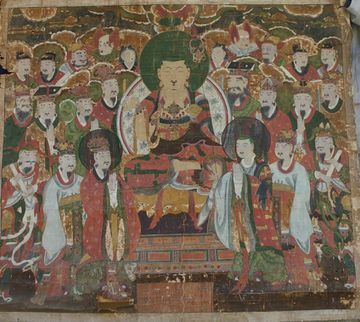정수사 지장시왕도
| 정수사 지장시왕도 Buddhist Painting of Jeongsusa Temple (Ksitigarbha Bodhisattva and Ten Underworld Kings) |
|
 정수사 지장시왕도, 국가문화유산포털, 문화재청. |
|
| 대표명칭 | 정수사 지장시왕도 |
|---|---|
| 영문명칭 | Buddhist Painting of Jeongsusa Temple (Ksitigarbha Bodhisattva and Ten Underworld Kings) |
| 한자 | 淨水寺 地藏十王圖 |
| 주소 | 경상북도 의성군 구천면 장국길 195 |
| 지정(등록) 종목 | 시도유형문화재 제372호 |
| 지정(등록)일 | 2005년 11월 7일 |
| 분류 | 유물/불교회화/탱화/기타 |
| 시대 | 조선시대 |
| 수량/면적 | 1폭 |
| 웹사이트 | 정수사 지장시왕도, 국가문화유산포털, 문화재청. |
|
|
|
해설문
국문
지장시왕도는 지옥에서 고통 받는 중생을 구원하는 지장보살과, 지옥에서 인간들이 지은 죄의 가벼움과 무거움을 가리는 열 명의 심판관인 시왕을 비롯하여 판관, 사자, 옥졸 등을 그린 불교 그림이다.
머리를 짧게 깎은 지장보살이 끝에 쇠고리가 달린 지팡이와 투명한 구슬을 양손에 각각 쥐고 연꽃깔판 위에 양반다리로 앉아 있다. 지장보살의 왼쪽과 오른쪽에는 도명존자(道明尊者)*와 무독귀왕(無毒鬼王)**이 보좌하고 있고, 그 주위로 시왕을 비롯한 판관, 사자, 옥졸 등이 둘러싸고 있다.
불화에 있는 기록으로 1731년에 제작되었음을 알 수 있다. 화면의 인물 배치와 구성, 표현 기법 등에서 조선 전기 불화 양식을 이어받은 흔적을 찾아볼 수 있다.
불화에 일반적으로 사용하는 짙은 붉은색, 초록색, 파란색, 누런색, 흰색의 물감을 사용하였다. 이 외에도 조선 시대에는 아껴 쓴 금가루를 사용하여 채색하여 화려하게 표현한 것이 특징이다. 안정된 구도와 뛰어난 색채미를 보여주는 작품으로 조선 후기 불교 그림을 연구하는 데 귀중한 자료이다.
- 도명존자: 지장보살의 왼쪽에 있는 보살. 설화에 나타나는 도명존자는 중국 양주에 있는 개원사의 승려로서 우연히 죽은 후의 세계를 경험하고 지장보살을 보좌하는 역할을 하게 되었다고 한다.
- 무독귀왕: 지장보살의 오른쪽에 있는 보살. 그 이름에서 나타난 것처럼 사람들의 악한 마음을 없애준다고 한다.
영문
Buddhist Painting of Jeongsusa Temple (Ksitigarbha Bodhisattva and Ten Underworld Kings)
This Buddhist painting was made in 1731. It depicts a Ksitigarbha Bodhisattva triad with Ten Underworld Kings, judges and other retinues.
Ksitigarbha Bodhisattva is depicted in the center with a shaved head, seated on a lotus pedestal with Demon King Wudu on the left and a sage monk named Daoming on the right. Ksitigarbha Bodhisattva, or the Bodhisattva of Great Vows, took on the responsibility of rescuing unfortunate beings from hell and vowed to postpone Buddhahood until all beings are saved from the world of suffering. A stick with an iron hoop on top in his left hand and a wish-fulfilling jewel in his right hand are the characteristic features of Ksitigarbha Bodhisattva. His head aureole is painted green and his body aureole in painted white and decorated with lotus flowers.
Because Demon King Wudu and monk Daoming are Ksitigarbha Bodhisattva’s attendants, they were depicted with halos unlike the rest of the retinue. Demon King Wudu is wearing a crown and Daoming is portrayed with a shaved head. On either side of the triad are the Ten Underworld Kings, who preside over the judgment of the dead, and their entourages.
The colors used in the painting are dark shades of red, green, blue, yellow, and white, which are commonly used in Buddhist painting. Gold dust wad also used to add richness to the painting. The painting was done on hemp canvas and measures 1.5 m in width and 1.6 m in height.
- Do we differentiate 두광 and 신광 in translation?
영문 해설 내용
이 그림은 1731년에 제작된 것으로, 지장보살삼존과 시왕, 판관을 비롯한 권속들을 그렸다.
중앙에는 민머리의 지장보살이 연화대좌 위에 앉아 있고, 대좌의 왼쪽과 오른쪽에 무독귀왕과 도명존자가 서 있다. 지장보살은 지옥에서 고통받는 중생을 구원하며, 모든 중생을 구원할 때까지 성불을 미루는 보살이다. 끝에 쇠고리가 달린 지팡이와 여의주를 각각 왼손과 오른손에 쥐고 있는데, 이 두 물건은 지장보살을 나타내는 특징이다. 두광은 초록색으로 표현했고, 신광은 흰색 바탕에 파란색으로 연꽃을 장식했다.
무독귀왕과 도명존자는 지장보살을 협시하고 있기 때문에, 둘 다 머리에 광배를 표현해서 다른 권속들과 구별하였다. 무독귀왕은 머리에 관을 쓰고 있고, 도명존자는 민머리이다. 지장보살과 무독귀왕, 도명존자의 좌우측에는 저승에서 죽은 자의 죄를 심판하는 재판관인 시왕과 권속들이 있다.
불화에 일반적으로 사용하는 짙은 붉은색, 초록색, 파란색, 누런색, 흰색을 사용하였다. 이 외에도 금가루를 사용하여 화려하게 장식한 것이 특징이다.
삼베 바탕 위에 채색을 하였고, 크기는 폭 1.5m, 길이 1.6m 이다.